Ford Ranger (North America)
| Ford Ranger | |
|---|---|
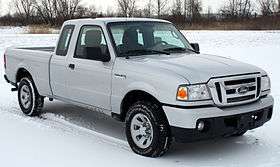 | |
| Overview | |
| Manufacturer | Ford |
| Production | 1983–2011 |
| Model years | 1983–2011 |
| Body and chassis | |
| Class | Compact pickup truck |
| Layout | Front-engine, rear- / four-wheel drive |
| Chronology | |
| Predecessor | Ford Courier |
| Successor |
Ford F-150 Ford Ranger |
The Ford Ranger is a compact pickup truck that was manufactured and marketed by Ford Motor Company from 1983 to 2012 model years for North America; from 1997 to 2011, a version was also manufactured and sold in South America. Introduced to replace the Ford Courier produced in Japan by Mazda, the Ranger was produced in two distinct generations. While introduced a year after the Chevrolet S-10, the Ranger would go on to become the best-selling compact truck in the United States from 1987 to 2004.[1]
Over its production life, the chassis and underpinnings of the Ranger would be used for various compact Ford trucks, most commonly as sport-utility vehicles. During the 1990s and 2000s, Mazda adopted a badge-engineered version of Ranger, taking on the B-Series nameplate (the reverse of the Ford Courier produced by Mazda).
Over its 29-year production run, Ford produced the Ranger via three different assembly plants in North America. The Ranger was produced at the Louisville Assembly Plant in Louisville, Kentucky from 1982 to 1999; from 1993 to 2004, production also was sourced from Edison Assembly in Edison, New Jersey. For its entire production run, the Ranger was produced at Twin Cities Assembly Plant in St. Paul, Minnesota. The final 2012 Ford Ranger produced on December 16, 2011, also ended 86 years of production at Twin Cities Assembly as well as the production of compact pickups in general in the United States.
First generation (1983–1992)
| First generation | |
|---|---|
 | |
| Overview | |
| Production | January 1982 – 1992 |
| Model years | 1983–1992[2] |
| Assembly |
Louisville, Kentucky, United States St. Paul, Minnesota, United States |
| Powertrain | |
| Engine |
V6 engines
Diesel engines
|
| Transmission |
Manual transmissions
|
| Dimensions | |
| Wheelbase |
107.9 in (2,741 mm) 113.9 in (2,893 mm) 125 in (3,175.0 mm) |
| Length |
Standard bed 1983–1988:175.6 in (4,460 mm) 1989–1992:176.5 in (4,483 mm) Long bed 1983–1988:187.6 in (4,765 mm) 1989–1992:188.5 in (4,788 mm) Supercab 1983–1988:192.7 in (4,895 mm) 1989–1992:193.6 in (4,917 mm) |
| Width |
1983–1988: 66.9 in (1,699 mm) 1989–1992: 66.8 in (1,697 mm) |
1983–1988
Ford began development of the Ranger in 1976, focusing on quality and fuel efficiency. The intent was to build a truck that was as capable as the full-size F-Series, but in a more economical package. The compact Ranger had a similar styling to the full-size Ford F-Series, used a similar architecture, and was offered with a four-wheel drive capability. This ability allowed the Ford Ranger to haul a 4-foot (1.2 m) wide sheet of plywood, which is a common standard for a pickup truck. In the compact Ranger, however, the space between the wheel wells was less than four feet; Ford designed the box with recesses to insert supports across the bed, allowing it to haul a standard sheet of plywood above the wheel wells.[3]
In addition, a key factor driving the development of the Ford compact truck was the 25 percent "Chicken tax" on imported trucks. Although Japanese truck manufacturers had circumvented the tariff by importing vehicles as cab-chassis trucks and installing the truck beds separately, building a truck in North America was a more practical option.
Ford began production of the model year 1983 Ranger on January 18, 1982 at the Louisville Assembly Plant,[4] hitting showrooms in March.[5] Available engines were the 72 hp (54 kW) 2.0 L and 82 hp (61 kW) 2.3 L OHC four-cylinders, a four-cylinder 59 hp (44 kW) 2.2 L Mazda/Perkins diesel, and a 115 hp (86 kW) 2.8 L Cologne V6. In 1985, a Mitsubishi-built 2.3 L turbo-diesel with 86 hp (64 kW) replaced the Mazda diesel engine, and in 1986, the 2.8-liter engine was replaced with a 140 hp (104 kW) 2.9 L Cologne V6. The Super-cab was introduced in 1986, offering an extra 17 inches (432 mm) of storage space behind the front seats, with a pair of jump seats available as an option. Also in 1986, the gauge cluster was modified to allow fitment of a factory tachometer. A lot of the parts of the interior such as the steering wheel, door handles, and the window cranks were similar to those in other Ford vehicles like the Bronco, Escort, and the F-Series.
Mid-year 1986 saw the introduction of the Ranger GT in California only. Available as a standard cab with a short or long bed, it had a 2.9-liter Cologne V6 with either a five-speed Mazda manual transmission or an optional A4LD automatic transmission putting power to a traction-lock differential. Inside, the pickup was equipped with special bucket seats, full instrument cluster, and an optional center console. Front and rear sway bars were installed and 14-inch aluminum wheels completed the package.
Second Generation 1989–1992
The truck received a facelift in 1988 for the 1989 model year, which included flush composite headlamps, new front fenders, hood, and grille, along with some upgrades to the frame. Inside, there was a modern new dashboard and steering column.
The new steering column included, on automatic transmission-equipped models, a column-mounted gear shift, and key removal on manual transmission models became a simpler, one-handed operation. Manual-equipped 1983–88 models had the key release button beneath the column on the left-hand side, requiring drivers to use both hands to remove the key.
Rear-wheel antilock brakes were added, and a 21 US gal (79 L; 17 imp gal) fuel tank was now optional on extended-cab models.
Beginning in 1989 (untill the end of 1997) the only transmission available on supercab models was the 5-speed Mazda M5OD-R1 manual transmission (while regular cab models were equipped with a manual or automatic transmission during 1989-1997 model years). The 2.0-liter engine was discontinued, and the 2.3 now had a distributor-less ignition system with two spark plugs per cylinder, giving it a 10 hp (7 kW) boost and better fuel economy.[6] The three-speed automatics were dropped, leaving only the A4LD. The new 155 hp (116 kW) 4.0 L Cologne V6 was added to the option list for all models in 1990. The 3.0-liter Vulcan V6 was also offered in the Ranger beginning in model year 1990. The 2.9-liter continued on alongside the 3.0-liter until model year 1992 when it was discontinued.
The Ranger GT was discontinued, although the Ford Truck Public Affairs office did build a prototype for 1990 powered by a 3.0 L SHO V6.[7][8]
Third generation (1993–2012)
1993–1997
| 1993–1997 | |
|---|---|
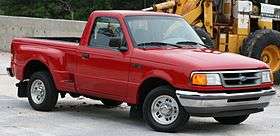 | |
| Overview | |
| Also called | Mazda B-Series |
| Production | August 1992 – July 1997 |
| Model years | 1993–1997 |
| Assembly |
Louisville, Kentucky, United States St. Paul, Minnesota, United States Edison, New Jersey, United States General Pacheco, Argentina |
| Body and chassis | |
| Body style |
2-door compact 2-door extended |
| Powertrain | |
| Engine |
2.3 L OHC I4 3.0 L Vulcan V6 4.0 L Cologne V6 |
| Transmission |
Manual 5-speed Mazda M5OD-R1 Automatic 4-speed A4LD 4-speed 4R44E 4-speed 4R55E 5-speed 5R55E |
| Dimensions | |
| Wheelbase |
107.9 in (2,741 mm) 113.9 in (2,893 mm) 125.2 in (3,180 mm) |
| Length |
184.3 in (4,681 mm) 196.3 in (4,986 mm) 198.2 in (5,034 mm) |
| Width | 69.4 in (1,763 mm) |
The redesign in 1992 for 1993 featured mild restyling, flush-mounted door glass, wider doors, and slight fender flares. The 1989-style dashboard remained, but the seats and door panels were new. The 2.9-liter engine was discontinued. The engines offered were offered in displacements of 2.3, 3.0 and 4.0 liters. A new "Splash" model was introduced, which had a flare side bed, unique chrome wheels, 1-inch (25 mm) lowered rear suspension and a 2-inch (51 mm) lowered front suspension (on 4x2 models), and special vinyl "Splash" decals on the sides and the tailgate.
The 1993 Splash trim level was offered with regular cab in arctic white, gloss black, red orange, and sky blue. The Mazda B-Series became a re-badged Ranger for the 1994 model year, but the Mazda B-Series did not offer an equivalent to the Splash model. While 1993 Rangers used R-12 Freon, 1994 model year saw the transition to CFC-free air-conditioning systems in compliance with the Clean Air Act. For the 1994 model year, the Splash trim had options which all included; a 1-inch (25 mm) lowered rear suspension and 2-inch (51 mm) lowered front suspension (on 4x2 models), flare side bed, an extended cab, and unique chrome wheels. The decals also underwent subtle changes. While the 1993–1994 models sported red, yellow and blue stripes, the 1995 to 1996 models had lime green stripes. Additionally, the available colors for the Splash model changed from the 1993–1994 models to the 1995–1997 models. The latter were offered in maroon, gloss black, white, and canary yellow.
 Ford Ranger dash panel
Ford Ranger dash panel Ford Ranger jump seat closed
Ford Ranger jump seat closed.jpg) Ford Ranger jump seat open
Ford Ranger jump seat open
Fall 1994 production (1995 model year) included a steering wheel modified to include a driver's side airbag and a redesigned dashboard which included a double DIN radio head unit. Also for 1995 (model year), SuperCab trucks could have a power driver's seat. The A4LD transmission was updated. 2.3- and 3.0-liter models got the 4R44E, while 4.0-liter trucks got the 4R55E. The front brakes were changed to use the same two-piston brake calipers as the second-generation Explorer, and four-wheel anti-lock brakes were added as standard on 4x4 and 4.0-liter models. From October 1995 (1996 model year), an optional passenger airbag (the first compact truck to offer one) became available, with a key-operated cutoff switch that allowed the airbag to be turned off for smaller passengers riding in the front seat. In October 1996, the 1997 model year brought in the first ever five-speed automatic transmission to be used by an American manufacturer. The 4.0-liter models were equipped with the 5R55E, while the 3.0-liter was still mated to the 4R44E.
- Powertrain
- 1994 – 2.3 L (2311 cc) OHC I4, 98 hp (73 kW), 133 lb·ft (180 N·m)
- 1995–1997 – 2.3 L (2311 cc) OHC I4, 112 hp (84 kW), 135 lb·ft (183 N·m)
- 1994–1996 – 3.0 L (2957 cc) Vulcan V6, 145 hp (108 kW), 165 lb·ft (224 N·m)
- 1994–1997 – 4.0 L (4016 cc) Cologne V6, 160 hp (119 kW), 225 lb·ft (305 N·m)
Mazda B-Series

For 1994, the third-generation Mazda B-Series was introduced. While the company continued to manufacture its own trucks in Japan and internationally, the North American version of the B-Series was now a badge-engineered version of the Ranger. The new B3000 and B4000 boasted Ford V6 engines, and the M5OD-R1 manual transmission returning to the options sheet. Extended cab models were available, as was four-wheel drive; Mazda made the B-Series available in two trim lines, LE and SE. The 3.0-liter B3000 was dropped for 1997.
1998–2012
| 1998–2012 | |
|---|---|
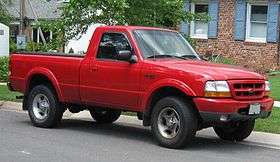 | |
| Overview | |
| Also called | Mazda B-Series |
| Production | August 1997 – December 16, 2011 |
| Model years | 1998–2012 |
| Assembly |
St. Paul, Minnesota, United States Edison, New Jersey, United States General Pacheco, Argentina |
| Body and chassis | |
| Body style |
2-door compact 2-door extended (1998–2011) 2+2-door extended (1999–2011) 4-door crew cab (South America) |
| Powertrain | |
| Engine | |
| Transmission |
Manual 5-speed Mazda M5OD-R1 Automatic 4-speed 4R44E 5-speed 5R55E |
| Dimensions | |
| Wheelbase |
111.6 in (2,835 mm) 117.6 in (2,987 mm) 125.9 in (3,198 mm) |
| Length |
188.5 in (4,788 mm) 200.5 in (5,093 mm) 202.9 in (5,154 mm) |
| Width | 70.3 in (1,786 mm) |
| Height |
68.3 in (1,735 mm) 69.4 in (1,763 mm) |
In 1997 for the 1998 model year, the Ranger got a major update to the same body design, by giving it a longer wheelbase and a 3-inch (76 mm) longer cab for the regular cab models (part of which provided more room in the interior). The automatic transmissions on extended cab models returned since 1989. The 1995 to 1997 model year interior look was retained. The twin I-beam front suspension was replaced by the wishbone-style system found on the Explorer and the front half of the frame was of "boxed", rather than C-channel construction. Rack and pinion steering was also added. The four-cylinder engine was bumped up to a 2.5-liter SOHC I4 giving it a six percent increase in power over the old 2.3-liter. It put out 117 hp (87 kW) and 149 lb·ft (202 N·m) of torque. Also, for the 2000 model year, amber rear turn signals were discontinued. 4x4 models were equipped with a PVH lockout system for the front axles. This system proved to be rather unreliable and was changed to a live axle setup in mid-2000.
The 2.5-liter engine was replaced by a new DOHC 2.3-liter Duratec inline-four in mid-2001. 2001 also saw the pushrod 4.0-liter V6 replaced by the SOHC version from the Explorer, bringing with it a beefier M5OD-R1HD manual transmission. Also in 2001, the five-speed automatic transmission that was introduced in 1997 for the 4.0-liter V6, was now also available with the 2.3- and 3.0-liter units. The Ranger received a facelift, including a new grille, hood, and front bumper, as well as updated headlights and taillights. SLP produced a version of the Ranger called "thunderbolt". This model included different options such as a unique front and rear bumper, air intake, exhaust and even a spoiler.
In 2004, the Ranger received minor updates to the grille, hood, and front bumper. New front bucket seats were also added in 2004 to meet the new U.S. Federal safety requirements. It retained the dash lines of the previous years trucks with an instrument cluster change. In 2006, the Ranger received more minor updates to the grille, front side markers and taillights, along with a bigger rear Ford logo that was now centered in the tailgate. It also received new larger mirrors similar to those found on other Ford trucks and SUVs.
 2001–2003 Ford Ranger extended cab
2001–2003 Ford Ranger extended cab 2004–2005 Ford Ranger extended cab
2004–2005 Ford Ranger extended cab 2006–2012 Ford Ranger regular cab
2006–2012 Ford Ranger regular cab
The latest Ranger offered a 143 hp (107 kW) 2.3-liter inline-four and a 207 hp (154 kW) 4.0-liter V6. The 3.0-liter Vulcan V6 was discontinued as of the 2009 model year. Ford uses code "R10" through "R19" in the fifth, sixth, and seventh VIN positions for all Rangers; R10, R14, and R18 are all rear-wheel drive; regular cab, two-door SuperCab, and four-door SuperCab respectively. R11, R15, and R19 are four-wheel drive; regular cab, two-door SuperCab, four-door SuperCab respectively.
In December 2009, Ford announced that specially-designed custom graphics would be applied to the Ranger beginning with the 2010 models. The feature was exclusive to Ford Dealers and allowed customers to pick a design that they wanted customized for their Ranger trims.[9]
For the 2011 and 2012 model year, the level trims were adjusted. The XL trim has the standard level, followed by the XLT and Sport trims. The latter two included Sirius radio as an optional feature.[10]
The Ford Ranger was the first small pickup to introduce dual airbags as safety features.[11] It received an "acceptable" frontal crash test rating from the Insurance Institute for Highway Safety when they were first tested in 1998, while many of its competitors received "marginal" or "poor" ratings at that time. The exception was the Toyota Tacoma, which also got an "acceptable" rating.[12][13]
The 2010 model year brought the addition of front seat combination head and torso airbags to improve passenger safety in a side-impact collision and earned "good" rating through the Insurance Institute for Highway Safety's side impact test. Also, electronic stability control was added for the 2010 models as standard equipment.[14]
In the Roof Strength Test conducted by Insurance Institute for Highway Safety, the Ford Ranger earned an Acceptable rating.[15]
- FX4 Level II
The FX4 Level II version comes with a special 31-spline 8.8-inch (223.5 mm) Ford 8.8 rear axle equipped with a Zexel-Torsen limited-slip differential, three skid plates, upgraded tow hooks, 31" BFGoodrich All Terrains, 15-inch forged Alcoa wheels, and Bilstein shocks. Inside, the Level II package added two-tone cloth seats, optional leather and rubber floors along with a six-CD MP3 headunit as standard options. The FX4 level II package was first available in 2003, though, in 2002 the very first "FX4" package, however, not the Level II, was available. The 2002 FX4 off-road package is identical to the 2003+ FX4 Level II package, since there wasn't a FX4 Level II package offered. The FX4 off-road package did differ from the FX4 Level II package after 2002. The 2002 FX4 off-road and 2003 FX4 Level II are often referred to be the "Holy Grail" of Rangers, since there were limited production of these trucks with both a manual transmission and manual 4x4. According to Ford, 17,971 Level IIs were built through 2007 (including the 2002), and 45,172 of the Off Roads were built from 2003–2009. The FX4 Off Road was available into 2009, but the Level II was stopped after 2007, though many Level II goodies could be ordered a la carte. In 2010 the Ranger discontinued the FX4 trim level for the US market but it remained available in the Canadian market.
The above pictures are of a 2006+ FX4 level 1. A Level II will have a special "Level II" decal just behind the front wheels in the secondary color paint as well as chrome "J" tow hooks.
- Ford Ranger EV


The Ford Ranger EV was a battery electric version of the Ranger produced for model years 1998 to 2002. The chassis of the four-wheel drive model was used, but the Ranger EV was strictly a rear-wheel drive vehicle. Unlike other versions, the EV featured a de Dion rear suspension. 1998 models employed lead-acid batteries while subsequent models used Nickel metal hydride (NiMH) batteries.
The Ranger EV is largely indistinguishable from a standard Ranger except for its grille. On EV models, a door for a charging port is located on the right third of the grille.
- Powertrain
- 1998– 1999 – 2.5 L (2507 cc) OHC I4, 117 hp (87 kW), 149 lb·ft (202 N·m)
- 2000– early 2001 – 2.5 L (2507 cc) OHC I4, 119 hp (89 kW), 146 lb·ft (198 N·m)
- late 2001–2002 – 2.3 L (2300 cc) Duratec I4, 135 hp (101 kW), 153 lb·ft (207 N·m)
- 2003–2010 – 2.3 L (2300 cc) Duratec I4, 143 hp (107 kW), 154 lb·ft (209 N·m)
- 1998–1999 – 3.0 L (2957 cc) Vulcan V6, 145 hp (108 kW), 178 lb·ft (241 N·m)
- 2000–2001 – 3.0 L (2957 cc) Vulcan V6, 150 hp (112 kW), 190 lb·ft (258 N·m)
- 2002 – 3.0 L (2957 cc) Vulcan V6, 146 hp (109 kW), 180 lb·ft (244 N·m)
- 2003–2004 – 3.0 L (2957 cc) Vulcan V6, 154 hp (115 kW), 180 lb·ft (244 N·m)
- 2005–2008 – 3.0 L (2957 cc) Vulcan V6, 148 hp (110 kW), 180 lb·ft (244 N·m)
- 1998–2000 – 4.0 L (4025 cc) Cologne V6, 160 hp (119 kW), 225 lb·ft (305 N·m)
- 2001–2010 – 4.0 L (4025 cc) Cologne V6, 207 hp (154 kW), 238 lb·ft (323 N·m)
Mazda B-Series
North America saw a redesigned B-Series again for 1998, with a larger base engine. A five-speed automatic transmission was available.The 1999 B-Series added four doors, a first in the extended-cab pickup truck market. In 2001, a more powerful SOHC version of the 4.0-liter V6 replaced the old OHV engine, while Ford's Duratec engine replaced the Lima engine in four-cylinder models the following year. 2007 was the last year for 3.0-liter B-Series trucks. For 2010, the B4000 Cab Plus SE model was discontinued in the United States. The full B-Series lineup was discontinued, in the United States, at the end of the 2009 model year, while the Ford Ranger remained in production.[16] The B-Series was sold in the Canadian market for one more model year.
The last Mazda B-Series rolled off the assembly line on December 11, 2009.
South America
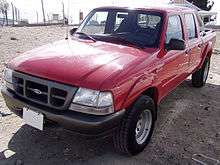
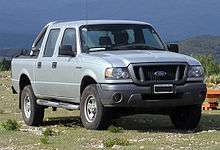
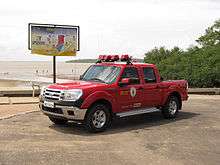
Starting in 1998, Ford began to phase out the Ford Courier name on its Mazda-produced compact pickups sold globally in favor of the Ranger nameplate (though the Courier remained in use in Australia). Consequently, exports of the North American-produced Ranger were primarily limited to South America, including Argentina, Brazil, and Chile.[1]
In 1995 Ford began exports of the Ranger from the United States to Argentina; initial exports started with two-door SuperCab equipped with the 4.0-liter gasoline Cologne V6. As demand increased, Ford made the decision to produce it locally in Buenos Aires, Argentina at the Ford General Pacheco Assembly Plant for the local market and subsequently for the rest of Latin America.[17]
The first Rangers produced at General Pacheco were built in 1996 with a single cab, gasoline engine version. By November 1997, supply was increased with both diesel and gasoline engines, two-wheel and four-wheel drive and different levels of equipment.
After two years of local production in Argentina, in 1998, Ford of Argentina introduced a redesigned version of the Ford Ranger. Featuring the same updates as its counterpart in the United States, a new four-door double cab body variant exclusive to South America made its debut.[18] As Ford was developing the functionally similar Ford Explorer Sport Trac at the time, the double-cab Ford Ranger was not produced or marketed in the United States or Canada.
To better match the needs of local buyers, Ford of Argentina replaced the 4.0L V6 with two different powertrain options, including a 3.0-liter turbocharged four-cylinder diesel with 163 hp (122 kW) and 280 lb·ft (380 N·m) of torque mated to an Eaton FSO-2405-A five-speed manual transmission.
The 2001 exterior facelift given to North American Rangers was not carried over to South American versions, with the 1998 front bodywork remaining until the 2003 model year. For 2004, both versions were given the same grille (though Argentine-produced versions were designed with projector-style headlamps).
Following a US$156.5 million upgrade to the General Pacheco factory in 2007,[19] several upgrades were made to the South American Ranger; a number of them would diverge the model from its US counterpart. For 2008, the Ranger received a makeover with a grill and headlights similar to the 2006 North American version; bed extenders became available for all boxes.[20]
For 2010, the Ranger was given its largest facelift since 1992. To allow for a more aggressive stance, the hood, front fenders, and front bumper were replaced with a more aggressive and rounded design, including large wheel arches; on the doors, the handles were replaced by a pull-out design. For the first time, the Ranger wore the Ford corporate three-bar grille. Inside, the interior design introduced in 2008 remained, with both previous engine configurations.[21][22] A new option (for Argentina and Brazil) included an engine powered by compressed natural gas, making it the first pickup truck to offer a factory-built natural gas vehicle (NGV) commercially available in those countries.[21][23]
In 2012, Ford of Argentina replaced the US-derived Ranger with the larger Ranger T6. Designed by Ford of Australia, the Ranger T6 consolidated the Ford- and Mazda-based versions of the Ranger onto a single platform sold globally (outside the United States and Canada)
Ford Ranger (Argentina) wheelbases and bed lengths:[24]
- 1998–2012 – 111.5 inches (2,831 mm) – 6 ft. bed (1,732mm) Single Cab
- 1998–2012 – 117.6 inches (2,987 mm) – 7 ft. bed (2,129mm) Single Cab
- 1998–2012 – 125.7 inches (3,192 mm) – 5 ft. bed (1,467mm) Double Cab
Engines:[24]
| Engine | Years | Power | Torque |
|---|---|---|---|
| 2.3 L Duratec HE gasoline I4 | 2004–present | 148 hp (110 kW) | 159 lb·ft (216 N·m) |
| 3.0 L Power Stroke diesel I4 | 2004–present | 163 hp (122 kW) | 280 lb·ft (380 N·m) |
Discontinuation and future
It was reported in 2005 that an all-new Ranger, codenamed P273, was in the works to be introduced by 2010.[25] The P273 was slated to be a world pickup, presumably to be merged with the Mazda world pickups. A 2007 Ranger for the Thai market based on the Asian 4Trac concept was unveiled; in the end, it did not replace the North American truck.
In the years leading up to the Ranger's demise, its competitors, from the Nissan Frontier to the Toyota Tacoma have been redesigned and enlarged towards the mid-size market, leaving the Ranger the only truck in the US compact market segment. The Ranger remained a decent seller for Ford,[26] with fleet customers buying them regularly as well as those individuals seeking good fuel mileage in a compact truck (at the time, the Ranger had higher fuel economy than any other pickup with its Mazda inline-four engine).
Ford initially considered a smaller-than-F-150 pickup truck, one based on the F-Series (following the older F-100 offering). This proposal was cancelled in favor of offering an EcoBoost engine in the F-150 product line.[27]
One factor as to why the Ranger will no longer be available in the United States is that the new global platform Ford Ranger (T6) is simply too close in size to the F-150. Another factor is due to declining sales, as Ford's Vice President of Global Product Development, Derrick Kuzak, notes that the compact pickup market in the United States has been declining for the past 15 years, dropping from eight percent of the industry in 1994 to around two percent in 2010. The ending of the Ranger in the United States also marks a departure for Ford from the compact truck segment after 30 years.[28]
On June 22, 2011, a report from the United Auto Workers 879, which represents workers at the factory where the North American Ranger is produced, was released which stated that production of the Ranger was planned to end by December 22, 2011.[29] The final North American-built Ranger, a white, extended-cab Sport model purchased by pest-control company Orkin, was produced at the St. Paul plant on December 16, 2011.[30] 2011 was the last model year of retail Ranger sales, while 2012 was the final model year of fleet sales. The Ranger was effectively replaced by the F-150 with EcoBoost V6 engines.
On August 25, 2015, reports began circulating that Ford is planning to bring the Ranger back to production as an entry in the 2018 model year.[31] If all this goes according to plan, the vehicles would be built at its Wayne, Michigan plant. The comeback is reportedly due to the recent resurgence in the mid-size pickup segment, which has seen its rivals experience excellent sales and demand from customers. The move would preserve some U.S. union jobs after the Focus and C-Max is moved to Mexico in 2018 amid contract negotiations with the UAW.[32]
Variants
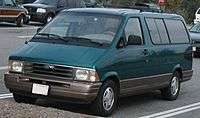
.jpg)
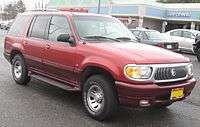

- Ford Aerostar
For the 1986 model year, the Ford Aerostar was launched as the first minivan from Ford Motor Company. Featuring a similar sloped-nose "one-box" body design introduced the same year on the European Ford Transit van, the Aerostar was based on a dedicated platform. As the 1984-1995 Chrysler minivans derived their components from the Chrysler K-Cars, the Aerostar sourced few components from the Ranger, mainly engines and transmissions, it uses its own independent front suspension along with rack and pinion steering, a coil sprung live rear axle, riding in a unibody platform, not a body-on-frame design as the Ranger.
Sold in a single generation, the Aerostar was discontinued after the 1997 model year, replaced by the front-wheel drive Ford Windstar and Mercury Villager.
- Ford Bronco II
Following the transformation of the Bronco into a full-size SUV for the 1978 model year, Ford product planners sought to create a replacement for the popular 1966 to 1977 generation. Using a shortened Ranger four-wheel drive chassis, the 1983 Bronco II was only slightly longer and wider than the 1966 generation. In sharp contrast to its spartan predecessor, the Bronco II offered all of the convenience features available on any Ranger. Unlike its larger namesake, the Bronco II was not designed with a removable top; it was distinguished with large side windows which extended into the rear roofline.
As part of a redesign, the Bronco II was enlarged, becoming the Ford Explorer Sport for the 1991 model year.
- Ford Explorer/Mercury Mountaineer/Mazda Navajo

.jpg)
For the 1991 model year, the Bronco II was redesigned for wider market appeal, becoming the Ford Explorer. To increase its appeal as a family vehicle, a five-door version was introduced; the three-door was renamed the Ford Explorer Sport. While the Ranger chassis remained in use, the Explorer was much longer than the Bronco II (mostly as a result of the second set of doors). As before, the Ranger and Explorer shared interiors and other components, though visible parts commonality was reduced over the Bronco II. In 1995, as part of a major redesign, the Ranger front bodywork was removed; the Explorer became the first Ford truck to end the use of Twin I-Beam front suspension.
Alongside the five-door Ford Explorer, Ford re-introduced the Bronco II with a three-door version of the Explorer for 1991. The three-door was sold under the Explorer and Explorer Sport names. To address the stability problems of the Bronco II, the three-door Explorer had an 8-inch longer wheelbase and was nearly a full foot longer in length. In contrast to the unique roofline of the Bronco II, the three-door Explorer wore a similar roofline to the five-door, with a raked "C-pillar" as an identifying feature. In 1998, the popularity of the Explorer Sport was noted, as the name was adopted for all three-door Explorers. For 2001, the Sport was given its own front-end styling (shared with the Sport Trac). Due to the declining popularity of three-door SUVs, the Explorer Sport was not redesigned alongside the five-door Explorer for 2002, with the facelifted 2001 version ending production in 2003.
From 1991 to 1994, Mazda sold the three-door Explorer as the Mazda Navajo. Equipped similar to the Explorer Sport and Explorer XLT three-door, the Navajo differed largely in exterior trim and wheels, with the interior differing only in the instrument panel lettering. Due to the slow sales of three-door SUVs, the Mazda Navajo was discontinued during the 1994 model year.
In 1997, the Mercury division introduced the Mercury Mountaineer as a badge-engineered version of the Ford Explorer five-door; it was sold until the discontinuation of the Mercury brand in 2010. As part of the development of the 2002 third-generation Ford Explorer, Ford developed a dedicated mid-size SUV chassis for the Explorer and Mountaineer, ending their use of the Ranger chassis after the 2001 model year.
- Ford Explorer Sport Trac
For the 2000 model year, Ford introduced the Ford Explorer Sport Trac as its first crew-cab compact pickup in North America. Though Ford already produced a crew-cab Ranger in Argentina, the Explorer Sport Trac was intended as a personal-use vehicle rather than a work vehicle. The Explorer Sport Trac was a combination of several vehicles: the Ranger long-wheelbase chassis, the Explorer Sport front bodywork, F-150 tailgate, an all-new composite bed, and a cab formed from the five-door Explorer.
As with the Ranger and Explorer three-door, the first generation Sport Trac was powered solely by V6 engines, with a 4.6-liter Modular V8 option beginning for model year 2006, though both two and four-wheel drive configurations were available. In 2006, the Explorer Sport Trac adopted the Ford mid-size SUV platform, ending the production of the Ranger-based Explorer; in 2010, the model was discontinued.
Sales
| Calendar year | US sales |
|---|---|
| 1997 | 298,796[33] |
| 1998 | 328,136[34] |
| 1999[35] | 348,358 |
| 2000 | 330,125 |
| 2001[36] | 272,460 |
| 2002[37] | 226,094 |
| 2003 | 209,125 |
| 2004[38] | 156,322 |
| 2005 | 120,958 |
| 2006[39] | 92,420 |
| 2007 | 72,711 |
| 2008[40] | 65,872 |
| 2009[41] | 55,600 |
| 2010[42] | 55,364 |
| 2011[43] | 70,832 |
References
- 1 2 Ford Ranger – Accessed March 8, 2011
- ↑ "Ford Ranger History". Edmunds.com. Retrieved May 17, 2015.
- ↑ Clark, Jim (December 1981). "Development of the Ranger" (PDF). Mini-Truck: 26–31.
- ↑ Stark, Harry A, ed. (1983). Ward's Automotive Yearbook 1983. Ward's Communications, Inc. p. 69.
- ↑ Stark, Harry A, ed. (1982). Ward's Automotive Yearbook 1982. Ward's Communications, Inc. p. 22.
- ↑ "1988 MPG ratings". Retrieved November 8, 2011.
- ↑ Hamilton, Frank. "SHO Down: Have you stomped in a Ford lately?". Minitruckin' (Spring 1990): 28–31.
- ↑ "SHO Ranger article copy" (PDF). Retrieved August 8, 2010.
- ↑ "Fancy a camouflage F-150? Graphics for entire Ford lineup coming soon" from Autoblog.com (December 18, 2009)
- ↑ 2011 Ford Ranger from media.ford.com (July 2010)
- ↑ "Air Bags in Ford Trucks". The New York Times. June 16, 1994. Retrieved July 12, 2016.
- ↑ "IIHS-HLDI: Ford Ranger regular cab". Iihs.org. November 18, 2009. Retrieved March 23, 2010.
- ↑ "IIHS-HLDI: Small pickups – Earlier Models". Iihs.org. Retrieved March 23, 2010.
- ↑ "IIHS-HLDI: Ford Ranger extended cab". Iihs.org. February 4, 2010. Retrieved March 23, 2010.
- ↑ "Roof strength evaluations: Small pickups". Iihs.org. Retrieved March 23, 2010.
- ↑ Bengt Halvorson (September 21, 2009). "B-Series, B-Seeing You: Mazda Leaves U.S. Pickup Market". The Car Connection. Retrieved October 9, 2009.
- ↑ Ford Ranger Latin America (in Spanish) – Accessed March 11, 2011
- ↑ Ford Pick up history in Argentina (in Spanish) – Accessed March 11, 2011
- ↑ Ford to invest US$156.5m in Pacheco facility- Accessed March 8, 2011
- ↑ Ranger 2008 (in Spanish) – Accessed March 8, 2011
- 1 2 presentó la nueva Ford Ranger 2010 (in Spanish) – Accessed March 8, 2011
- ↑ Ford Ranger 2010 (Mercosur), primeras imágenes y datos(in Spanish) – Accessed March 8, 2011
- ↑ Ford Ranger 2010 (Mercosur), primeras imágenes y datos (in Spanish) – Accessed March 10, 2011
- 1 2 Owner's manual (in Spanish) – Accessed March 8, 2011
- ↑ "Future Cars: Ford/PAG/Mazda". The CarConnection.com. March 30, 2005.
- ↑ "NEWS" (PDF). Retrieved March 23, 2010.
- ↑ "Ford tables plans for F-100 pickup". Edmunds Inside Line. Edmunds, Inc. August 8, 2008.
- ↑ Bowman, Zach (September 20, 2010). "U.S.-spec Ford Ranger to officially end production in 2011, Ford explains why". Autoblog. Retrieved October 9, 2010.
- ↑ "Report: For St. Paul Ford plant, end of line is Dec. 19". Autoblog. June 22, 2011. Archived from the original on June 22, 2011. Retrieved June 23, 2011.
- ↑ Williams, Chris (December 6, 2011). "St. Paul Ford plant sees final truck off the line". San Jose Mercury News. Archived from the original on December 16, 2011.
- ↑ "Ford plans to build Ranger at Michigan Assembly" from Detroit News (August 25, 2015)
- ↑ "Ford Said to Weigh Return of Bronco, Ranger Output to U.S." from Bloomberg News (August 26, 2015)
- ↑ http://www.theautochannel.com/news/press/date/19990106/press002196.html
- ↑ http://www.prnewswire.com/news-releases/ford-motor-company-topples-december-and-full-year-us-sales-records-71957662.html
- ↑ "Ford Motor Company Sets New Full Year U.S. Sales Record". Theautochannel.com. Retrieved April 28, 2009.
- ↑ "Ford Motor Company's December U.S. Sales Climb 8.2 Percent" (PDF). Ford Motor Company.
- ↑ "Ford's F-Series Truck Caps 22nd Year in a Row as America's Best-Selling Vehicle With a December Sales Record". Theautochannel.com. November 17, 2004. Retrieved April 28, 2009.
- ↑ "Ford Achieves First Car Sales Increase Since 1999". Theautochannel.com. November 17, 2004. Retrieved April 28, 2009.
- ↑ "Ford Motor Company 2007 sales". January 3, 2008.
- ↑ "F-Series drives ford to higher market share for third consecutive month" (PDF). Ford Motor Company. January 5, 2009. Retrieved May 14, 2009.
- ↑ "Ford caps 2009 with 33 percent sales increase, first full-year market share gain since 1995" (PDF). Ford Motor Company. January 5, 2010. Retrieved January 5, 2010.
- ↑ "Ford's 2010 sales up 19 percent – largest increase of any full-line automaker; foundation set for growth in 2011" (PDF). Ford Motor Company. January 4, 2011. Retrieved January 5, 2011.
- ↑ "2011 Ford Brand Sales up 17 Percent for the Year in U.S." (PDF). Ford Motor Company. January 4, 2012. Retrieved December 2, 2012.
External links
| Wikimedia Commons has media related to |
| « previous - Ford Motor Company light truck timeline, United States & Canada, 1980s–present | |||||||||||||||||||||||||||||||||||||||
|---|---|---|---|---|---|---|---|---|---|---|---|---|---|---|---|---|---|---|---|---|---|---|---|---|---|---|---|---|---|---|---|---|---|---|---|---|---|---|---|
| Type | 1980s | 1990s | 2000s | 2010s | |||||||||||||||||||||||||||||||||||
| 0 | 1 | 2 | 3 | 4 | 5 | 6 | 7 | 8 | 9 | 0 | 1 | 2 | 3 | 4 | 5 | 6 | 7 | 8 | 9 | 0 | 1 | 2 | 3 | 4 | 5 | 6 | 7 | 8 | 9 | 0 | 1 | 2 | 3 | 4 | 5 | 6 | 7 | ||
| Crossover | Compact | Escape | Escape | Escape | |||||||||||||||||||||||||||||||||||
| Mid-size | Edge | Edge | |||||||||||||||||||||||||||||||||||||
| Full-size | Freestyle | Taurus X | Explorer | ||||||||||||||||||||||||||||||||||||
| Flex | |||||||||||||||||||||||||||||||||||||||
| Sport-utility vehicle | Compact | Bronco II | Bronco II | ||||||||||||||||||||||||||||||||||||
| Mid-size | Explorer | Explorer | Explorer | Explorer | |||||||||||||||||||||||||||||||||||
| Full-size | Bronco | Bronco | Bronco | Expedition | Expedition | Expedition | |||||||||||||||||||||||||||||||||
| Excursion | Expedition EL/Max | ||||||||||||||||||||||||||||||||||||||
| Pickup truck | Compact | Courier | Ranger | Ranger | Ranger | Ranger | |||||||||||||||||||||||||||||||||
| Mid-size | Explorer Sport Trac | Explorer Sport Trac | |||||||||||||||||||||||||||||||||||||
| Full-size | F-Series (all) | F-Series (all) | F-Series (all) | F-150/F-250 | F-150 | F-150 | F-150 | ||||||||||||||||||||||||||||||||
| SVT Lightning | SVT Lightning | SVT Raptor | Raptor | ||||||||||||||||||||||||||||||||||||
| Super Duty | Super Duty | Super Duty | Super Duty | ||||||||||||||||||||||||||||||||||||
| Van | Compact MPV | Transit Connect | Transit Connect | ||||||||||||||||||||||||||||||||||||
| C-MAX | |||||||||||||||||||||||||||||||||||||||
| Minivan | Aerostar | Aerostar | |||||||||||||||||||||||||||||||||||||
| Windstar | Windstar | Freestar | |||||||||||||||||||||||||||||||||||||
| Full-size | Econoline | Econoline/E-Series | |||||||||||||||||||||||||||||||||||||
| Transit | |||||||||||||||||||||||||||||||||||||||
